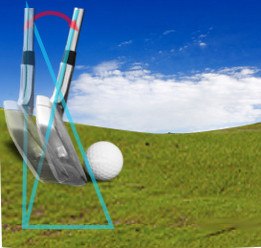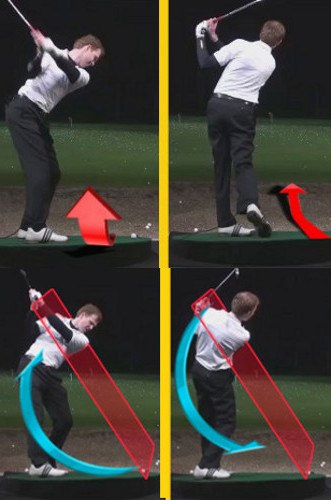
Playing downhill – where the slope falls straight toward the green or target – can cause some odd-looking golf shots. How come?
For starters, the slope has the effect of reducing the club's loft. For instance, if you're hitting down a hill with an 8° grade, your 34° 7-iron becomes a 26° 5-iron. Hence, the ball flies much lower than usual for the club you've chosen.
Downhill shots tend to veer right as well, sometimes with a fade or slice pushing them farther off line. That's because the slope pulls weight to your left (lead) foot, preventing a full backswing turn, keeping the body too far ahead of the ball on the downswing, and making it difficult to square the clubface at impact. The open club sends the ball squirting to the right.
In fact, even solidly struck shots from downhill lies will typically fly very low, land hot and roll considerably farther than expected. That's why it's important to understand the compensations necessary to handle these situations – which we'll examine in the next tip.

Golf Tip – Downhill Lie What the Ball Does
Playing from a downhill lie is one of the trickiest situations in all of golf. It is often side hill lies which get the attention when it comes to uneven ground, but playing from a downhill lie is sure to test your skills. Striking a solid shot and hitting your target should be considered a major accomplishment in this spot – something that many golfers cannot achieve. Of course, you aren't going to be able to hit such good shots by accident. Rather, you will need to have a plan in mind when this situation arises, and then you will need to execute that plan perfectly.
In this article, we are going to provide you with detailed information on how to handle a downhill lie. We will discuss what the ball is going to do when hit from a downslope, we will talk about the adjustments you need to make to your technique, and we'll cover strategy points as well. By the end of the article, you should have a great plan in mind for how you should approach this tricky scenario.
One hurdle you are going to run into right away with this shot is the fact that you can't find downhill lies on the driving range. Normally a golf instructor – or a golf instruction article – will tell you to work on any new shot you are trying to learn on the range before you attempt it on the course. That isn't really a possibility here. Most driving ranges are flat, leaving you with no opportunity to work on a downhill lie shot. So, in the absence of that opportunity, you will simply have to learn as much as you can about this technique and then give it a try when your ball comes to rest on this kind of slope out on the course. There will be some learning curve involved, but you should find your way sooner rather than later.
Before we get too far into this article, one thing that should be mentioned is the fact that you always want to play from flat ground whenever possible. It is great to learn how to handle shots from a downhill lie, but those shots will never be as easy to play as ones from flat ground. As part of your overall course management strategy, you should be looking for flat parts of the golf course to use as your targets. Playing from flat ground will allow you to be more aggressive with your shots, meaning you should have more birdie and par opportunities through the course of the day.
All of the content below is written from the perspective of a right-handed golfer. If you happen to play left-handed, please take a moment to reverse the directions as necessary.

What to Expect
You always want to be able to plan your golf shots as accurately as possible before you hit them. The more you know what about the ball is going to do in the air after it leaves your club, the better you can make decisions which will lead to a successful result. No one can see the future perfectly on the golf course – or anywhere else, for that matter – but making the best predictions you can make will improve your performance overall.
So what should you expect to happen when you hit a golf shot from a downhill lie? The following points are a good place to start.
- The shot will go farther. Many golfers are surprised to learn that a typical shot played from a downhill lie will fly farther than the same shot hit from a flat lie. This is the result of the lower trajectory that the ball will take. The slope of the ground is going to lead to a flatter launch angle, which means more horizontal movement and less vertical movement. Of course, you have to strike the ball cleanly in order to actually see these results come to fruition. As long as the ball comes off the middle of the club face, it should fly farther than a similar shot with the same club.
- The ball will fly lower. We already talked about this in the previous point, but it is important enough to warrant its own section. With a lower ball flight, you are not only going to have to adjust your distances, but you'll also need to think about what is going to happen when the ball lands. The shot isn't going to come to rest as quickly, so that big first bounce will need to factor into your planning. Also, it might be harder to carry something like a bunker or water hazard on the way to the green. Think twice before trying to hit a high shot from a downhill lie – doing so is incredibly difficult.
- You may push your shots to the right. When swinging on a downhill lie, your weight is naturally going to want to move in the direction of the target as you swing down. That means you will be sliding left and past the ball, and you may push the shot to the right as a result. Also, it is difficult to fully clear your hips in this situation, which again will encourage the ball to head to the right. You can do your best to keep these shots on line by carefully watching your balance as you swing. However, even accomplished players have trouble staying perfectly balanced in this spot. The loss of balance is always going to be the key threat on a downhill lie, and losing that battle will usually mean sending the ball out to the right of the target.
- You may hit some of these shots fat. In terms of catching the ball cleanly, your main concern here is going to be avoiding the fat shot. Since many golfers understand that this kind of shot is usually going to come out low, many of those players will lean back as they swing down in the hopes of helping the ball into the air. Of course, this move is only going to make a difficult situation even worse. The arc of the swing will bottom out too quickly when you make this move, and the result will be a fat shot. Your club head will catch the turf before it gets to the ball, you will lose much of your swing speed, and the shot will fall short of the target. This is a frustrating but predictable pattern for many golfers when swinging on a downhill lie. Avoid the temptation to help the ball up into the air and your play in this situation will improve.
In summary, you should expect the ball to come out flat when struck solidly on a downhill lie, and that shot will usually fly farther than normal as a result. Also, you will want to watch out for fat shots in this situation, and you need to expect some of your shots to miss slightly to the right as well. Keep all of these things in mind as you learn about the right technique to use on a downhill lie.

Adjusting Your Swing Properly
It should go without saying that some adjustments to your swing will be necessary if you are going to deal with these kinds of shots in a successful manner. Golf is a game of constant adjustment, and that certainly is true when you step onto uneven ground to hit a shot. There are specific adjustments which need to be made for every different kind of slope you might face. In this section, we are going to talk about how you can adjust your swing in order to meet the demands of playing from a downslope.
The next time you encounter a downhill lie, try the following changes to give yourself the best possible chance at success.
- Widen your stance. Any time you need to prioritize balance, the first thing you should do is widen your stance. When you set up with your feet farther apart, it will be easier to maintain your balance throughout the swing and into the follow through. This adjustment alone will not automatically allow you to stay balanced, but it will definitely be a good start. When you combine a wide stance with a controlled swing, you should be able to manage the movement of your body properly. While this certainly is an important adjustment to make, it should not be a dramatic one. Instead, you should try widening your stance by only a couple inches before getting started with your swing.
- Choke down on the grip. This is another important point to check off as you prepare to swing. Move your hands down slightly on the grip at address in order to reduce the chances of a fat shot. By coming down just an inch or two, you will shorten the effective length of the club and it will be easier to miss the turf on the way into the ball. Obviously, it will still be possible to hit a fat shot, so don't think that you can lean back and try to lift the ball without any consequences. Even when you are choked down on the grip, you still need to hit down through impact and follow the slope with your swing.
- Tilt your shoulders to the left. One of the best tips you can receive when playing from an uneven lie is to match your shoulders to the slope at address. So, in other words, you are going to tilt your shoulders down to the left when on a downhill lie. And, conversely, you would tilt them to the right when playing from an upslope. By setting your shoulders to match the slope, you should have an easier time swinging along the slope – and you will have a good chance to catch the ball cleanly at impact. Set your shoulders to match the slope of the ground and then do your best to keep them tilted throughout the swinging action.
- Play the ball in the middle of your stance. If you let your ball position move too far forward on this kind of shot, it will be difficult to catch the ball solidly before the club moves back up away from the ground. On the other hand, moving it too far back is going to create a steep swing and a huge divot. Your best bet here is to split the difference and place the ball perfectly in the middle of your stance. With a middle ball position, you can focus on balance and do your best to take any lateral motion out of your swing.
None of the changes you need to make to your technique are particularly complicated, or even significant. You are going to widen your stance, choke down on the grip, and tilt your shoulders to match the slope of the ground. Also, you are going to position the ball in the middle of your stance for a standard shot. If you can check all of these simple boxes, your performance from a downhill lie is going to improve dramatically. In fact, you might be surprised to find how comfortable you suddenly feel on a downslope just by preparing yourself properly.

Some Course Management Advice
Every shot you hit during a round of golf needs to be carefully planned from a course management perspective. It is easy to take course management for granted, failing to give it your full attention as you just aim at the hole and swing away. It shouldn't be a surprise to learn that such a plan rarely yields positive results. If you are going to take a step forward in your game – whether you are playing from a downhill lie or any other kind of lie – you will need to manage your decisions wisely.
So what kind of course management strategies come into play when dealing with a downslope? First, you need to understand that you will never be as accurate as you would be from the same distance on flat ground. That means you shouldn't be willing to take on aggressive targets when swinging down the slope. Rather than going for a hole location cut near to a water hazard, for example, you should aim to the safe side and give yourself some room for error. Even if you think you might be able to pull off the shot, it is best to play it safe and avoid making a big mistake.
Another strategy key goes back to the point we made earlier regarding the ball going farther from a downslope. Even if you have adjusted your club selection to plan for a longer shot, you still need to be aware of the possibility of your shot sailing beyond the green. So, as you look at the green and pick out a smart target, pay attention to what lies beyond the putting surface. How badly would your scorecard be damaged by a shot that flies too far? If there is nothing particularly worrisome back there, feel free to be aggressive. However, if a stiff penalty is waiting – like a hazard or out of bounds stakes – think about playing the ball short to avoid such a severe punishment. You are already in a bit of trouble by having to play off the downhill lie, don't make things worse by making a mental mistake.
The final course management point we are going to make in this section has to do with knowing yourself. As you gain experience playing from downhill lies, you will get more and more comfortable with what the ball is going to do when it leaves your club. Do you hit low line drives from this kind of lie, or are you able to get some lift on the shot? Do you tend to miss to the right, as is common for many players in this situation? Knowing your own personal tendencies will allow you to make wise course management choices. Even the best golf teacher in the world can't tell you for certain how to handle specific situations, because only you know your game well enough to make the right choices. Trust yourself, and blend your knowledge on this kind of shot with your past experiences to put together a perfect plan.
One of the most important things you can take away from this article is the crucial role that course management plays in the game of golf. If you are like most other amateur golfers, you probably don't give course management the respect that it deserves. As a result, your scores are higher than they should be. During your next round, commit yourself to thinking through each shot before you put the club in motion. As shocking as it might seem, that may be all you need to do in order to elevate your level of play.

Hitting Short Game Shots from a Downhill Lie
To wrap up this discussion, we are going to turn our attention to the short game. As you already know, the short game is a vital piece of the overall golf puzzle. Without a great short game, all the quality long shots in the world won't do you a bit of good. Solid ball striking is fun, and certainly important, but it is only useful when it has a short game to match.
Just as is the case with the full swing, playing short game shots from a downhill lie does present some specific challenges. As far as putting is concerned, you shouldn't have too much work to do in this situation. You are still going to be rocking the putter back and through, and the rest of your body should still remain quiet – just the same technique you use when the green is flat. The only difference here is you may need to work a little harder to setup over the ball in a balanced position. Spread your feet a bit wider to help steady yourself at address, and focus completely on balance while the putter is in motion. As long as you stay balanced, a solid putt should be soon to follow.
Of course, it should go without saying that chipping from a downhill lie is going to be more complicated than putting. A chip shot is nothing more than a miniature swing, so you will have to have a plan in place to deal with this situation. Fortunately, most of the same tips that apply to the full swing will work here as well. You want to stand with your feet a little wider apart, you want to choke down on the grip of the club, and you want to focus on balance. Also, setting your shoulders to match the slope is again a good idea, as that is going to help you make solid contact.
In terms of planning a chip shot, remember that the ball is going to come out lower than it would have otherwise. You can use something like a lob wedge to get some height on the shot, but you will still lose loft as compared to your typical chip with that same club. Always plan on more bounce and more roll when you need to chip from the downslope. It is easy to make the mistake of trying to hit the perfect chip shot when facing this kind of lie, but doing so is just asking for trouble. Instead, play it safe and make sure you are at least able to take your putter out of the bag for your next stroke.
Playing from a downhill lie is always going to be a challenge, but you can rise to this challenge with the right techniques and plenty of confidence in yourself. While it is hard to practice this kind of shot on the range, you should run into it often enough on the course that you will gradually become comfortable with how it works. Good luck!






